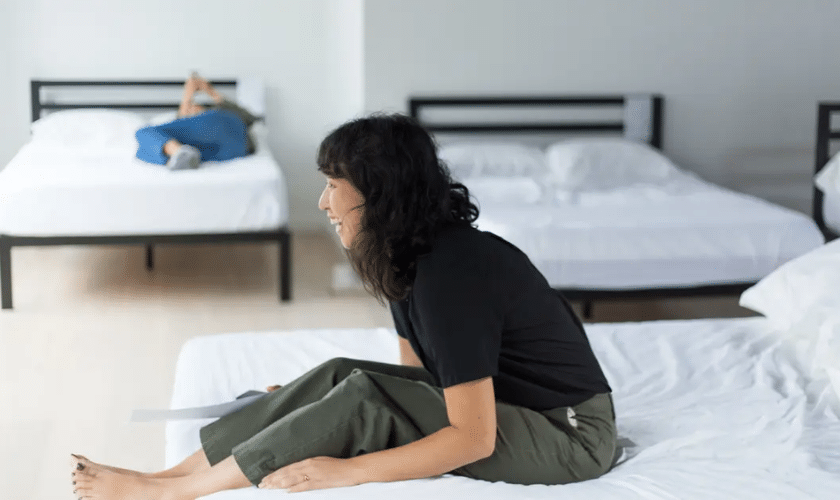
Imagine this: after a long, exhausting day, you finally get to sink into your bed, ready to drift off into a peaceful slumber. But instead of the restful sleep you crave, you spend the night tossing and turning, struggling to find a comfortable position. The culprit? Your mattress. A bad mattress can wreak havoc on your sleep quality, leaving you tired, achy, and irritable.
Buying a new mattress is a significant investment, not just financially but in terms of your overall health and well-being. With so many options available, from memory foam to hybrid, firm to plush, it’s easy to feel overwhelmed. That’s why testing a mattress before making a purchase is crucial. In this blog, we’ll explore the importance of trying out a mattress before you buy, how to properly test one, and what factors to consider to ensure you make the best choice for your sleep needs.
The Importance of Testing a Mattress Before Buying
Ensuring Comfort and Support
A mattress might look perfect online or in a showroom, but the real test lies in how it feels when you lie down. Comfort and support are highly subjective and can vary greatly from person to person. What feels like a cloud to one person might feel like a rock to another. Testing a mattress allows you to determine if it provides the right balance of softness and support for your body.
Identifying Potential Pressure Points
Everyone has unique pressure points that need adequate support to prevent pain and discomfort. When you test a mattress, you can identify if it alleviates pressure from areas like your shoulders, hips, and lower back. A mattress that doesn’t properly support these areas can lead to poor sleep and chronic pain.
Assessing Motion Isolation
If you share your bed with a partner, motion isolation becomes an important factor. Testing a mattress can help you gauge how well it absorbs movement, ensuring you won’t be disturbed by your partner’s tossing and turning. A mattress with good motion isolation can significantly improve the quality of sleep for both partners.
How to Properly Test a Mattress
Take Your Time
Don’t rush the process. Spend at least 15-20 minutes lying on each mattress you’re considering. This gives your body enough time to adjust and provides a more accurate sense of how the mattress feels over an extended period.
Try Different Positions
It’s important to test the mattress in various sleeping positions, especially the ones you most frequently use. Whether you’re a back, side, or stomach sleeper, make sure the mattress provides adequate support and comfort in each position.
Bring Your Pillow
Bring your own pillow when testing mattresses. This adds a level of familiarity and helps you better assess how the mattress will feel with your regular sleep setup. Your pillow plays a significant role in maintaining proper spinal alignment, so it’s important to test the mattress in combination with it.
Dress Comfortably
Wear comfortable clothing that allows you to move freely and lie down naturally. Tight or restrictive clothing can affect how you perceive the mattress’s comfort and support.
Factors to Consider When Choosing a Mattress
Mattress Type
There are several types of mattresses available, each with its own set of benefits and drawbacks:
- Innerspring Mattresses: Known for their traditional feel and bounciness, innerspring mattresses offer strong support but may not provide the same level of pressure relief as other types.
- Memory Foam Mattresses: These conform to your body’s shape, providing excellent pressure relief and support. However, they can retain heat, making them less suitable for hot sleepers.
- Latex Mattresses: Made from natural or synthetic latex, these mattresses offer good support and durability, with a slightly bouncier feel than memory foam.
- Hybrid Mattresses: Combining innerspring coils with foam or latex layers, hybrid mattresses aim to offer the best of both worlds: support, comfort, and pressure relief.
Firmness Level
Mattress firmness is a key factor in determining comfort. Most manufacturers offer a range of firmness levels, from soft to extra firm. Your preferred firmness level will depend on your sleeping position, body weight, and personal preference:
- Soft: Best for side sleepers and those who prefer a plush feel.
- Medium: Suitable for a variety of sleeping positions, offering a balance between support and comfort.
- Firm: Ideal for back and stomach sleepers, providing strong support to maintain proper spinal alignment.
Temperature Regulation
Temperature regulation is crucial for a good night’s sleep. Some mattresses, particularly memory foam, can trap heat and make you feel uncomfortably warm. Look for mattresses with cooling technologies, such as gel-infused foam or breathable materials, to ensure you stay cool throughout the night.
Durability and Longevity
A mattress is a long-term investment, so durability is an important consideration. Higher-quality materials and construction typically result in a longer-lasting mattress. Check the warranty and read reviews to get a sense of the mattress’s durability and longevity.
Investing in a new mattress is an important decision that can significantly impact your sleep quality and overall health. By taking the time to test different mattresses, you can ensure you find the perfect fit for your comfort, support, and sleeping preferences. Remember to consider factors like mattress type, firmness, temperature regulation, and durability to make an informed choice.
At Centerton Mattress Store, we understand the importance of finding the right mattress. Our knowledgeable staff is here to guide you through the process, offering expert advice and a wide selection of mattresses to suit every need. Visit us today to experience the difference of testing a mattress before you buy and take the first step towards better sleep.
FAQs
- Why is it important to test a mattress before buying?
Testing a mattress before buying ensures you find one that offers the right comfort and support for your body, helping to prevent sleep disturbances and chronic pain. - How long should I spend testing a mattress in the store?
Spend at least 15-20 minutes lying on each mattress in various sleeping positions to get an accurate sense of its comfort and support. - What should I wear when testing a mattress?
Wear comfortable, loose-fitting clothing that allows you to move freely and lie down naturally. - Should I bring my own pillow to the mattress store?
Yes, bringing your own pillow helps you better assess how the mattress will feel with your regular sleep setup and maintain proper spinal alignment. - What factors should I consider when choosing a mattress?
Consider mattress type, firmness level, temperature regulation, and durability to ensure you make the best choice for your sleep needs. - How can I tell if a mattress has good motion isolation?
Test the mattress with your partner by having one person move around while the other stays still to see how much movement is transferred. - What if I can’t decide between two mattresses?
If you’re torn between two options, consider factors like warranty, return policy, and reviews. Some stores also offer trial periods, allowing you to test the mattress at home.

